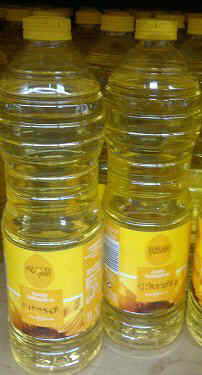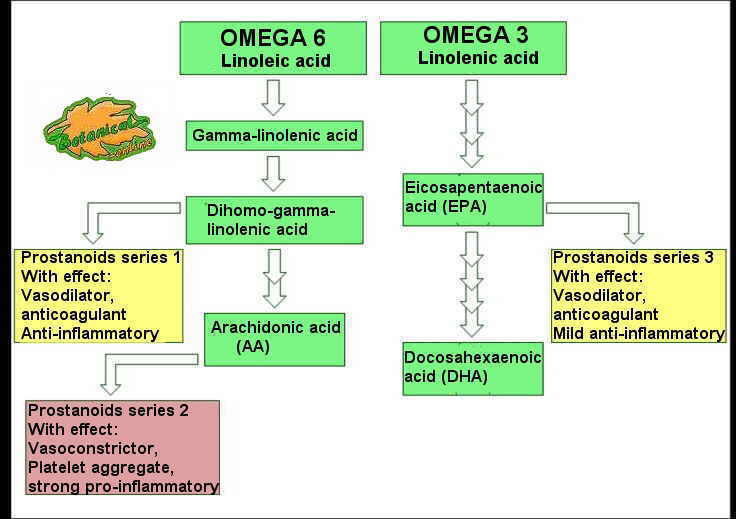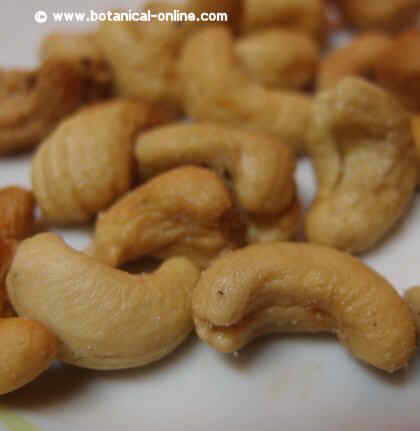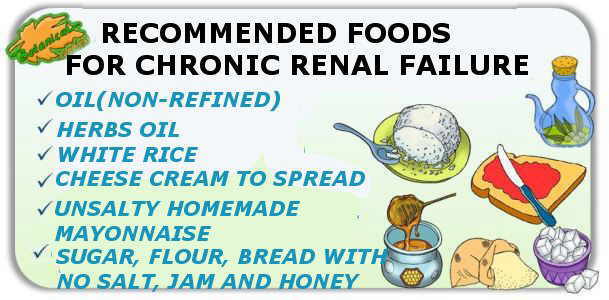Characteristics and properties of linoleic acid Omega 6 (LA)
PROPERTIES OF LINOLEIC ACID (LA)
What is linoleic acid?
Linoleic acid (C18: 2), is a fatty acid belonging to the group of omega 6 fats, and therefore, it is a polyunsaturated fatty acid.
Linoleic acid (omega 6), along with linolenic acid (omega 3), is one of the essential fatty acids that exist, that is, fats that the organism has to obtain from food, since it is not able to synthesize them by itself.
The structure of this fatty acid is formed by a chain of 18 carbon atoms containing 2 double bonds. It is represented as C18: 2.
What is the formula of linoleic acid?
The chemical molecular formula of linoleic acid is:
H3C- (CH2) 4 -CH = CH-CH2 -CH = CH- (CH2) 7 -COOH
Types of omega 6 fats

Bottles of sunflower oil, which is the vegetable oil richest in linoleic acid
Through linoleic acid the body can synthesize other polyunsaturated fatty acids of longer chains, such as the following:
- Linoleic acid (C18: 2)
- Gammalinolenic acid (C18: 3)
- Dihomoγlinolenic acid (C20: 3) (PG1, TX1)
- Arachidonic acid or AA (C20: 4) (PG2, TX2)
Properties of linoleic acid
The body needs linoleic acid to work properly. Among the main functions of linoleic acid (omega 6) are the following:
- Correct functioning of the immune system
- Formation of cell membranes
- Formation of hormones
- Correct formation of the retina and for a good vision
- Functioning of neurons and neural chemical transmissions
- Regulate the processes of inflammation of the organism through the formation of prostaglandins
Linoleic acid is an essential fatty acid that, after reactions produced by enzymes, is the precursor of the following fatty acids that have longer chains, producing as final product the AA.

Scheme on the products that are formed from the fatty acids and their effects on the organism, Produced by © Botanical-online
Properties of intermediate fatty acids
The resulting intermediate fatty acids such as Gamma-linolenic acid (C18: 3) or as Dihomo-γ-linolenic acid (C20: 3), can give rise to confusion given its name, but even if they are named in a similar way to some fatty acids Of the family of omega 3, they are different and are not part of it.
These fatty acids belong to the family of omega 6.
Dihomo-γ-linolenic acid (C20: 3) produces substances called eicosanoids, such as prostaglandins, thromboxanes and leukotrienes.
Eicosanoids are vital for proper function of our immune system, and interfere with inflammation and blood coagulation systems. But not all cause the same effect in our body.
Eicosanoids are series 1 and have highly inflammatory, vasoconstricting and platelet aggregating effects in our body.
Eicosanoids of the series 1 and 2 have the opposite effects to the eicosanoids of the series 3.
What foods contain linoleic acid?
We can find linoleic acid in foods of plant origin, as for example:
- In most vegetable oils, such as sunflower oil, soybean oil, corn oil, etc.
- In the form of gamma-linolenic acid, we find it in vegetable foods such as borage oil and evening primrose oil.
- In the form of Dihomo-γ-linolenic acid, we find it in foods of animal origin like fish oils.
- In the form of arachidonic acid, we find it in all kinds of fats of animal origin, like meat fats.
* More information: Foods rich in omega 6
Omega 6 supplements
When you want to treat any of the diseases described above, such as arthritis, bronchitis, menstrual pain, lupus, carpal tunnel syndrome, tendinitis, etc.
Supplements of omega 6 or supplements that can be used are:
- Black currant seed oil
- Borage oil
- Evening primrose oil
- Sesame oil
- Wheat germ oil
- Linseed oil
- Unrefined sunflower oil
* Related information:
![]() More information on fats.
More information on fats.








